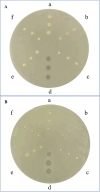Antimicrobial activity of lipids extracted from Hermetia illucens reared on different substrates
- PMID: 38261012
- PMCID: PMC10806025
- DOI: 10.1007/s00253-024-13005-9
Antimicrobial activity of lipids extracted from Hermetia illucens reared on different substrates
Abstract
As the problem of antimicrobial resistance is constantly increasing, there is a renewed interest in antimicrobial products derived from natural sources, particularly obtained from innovative and eco-friendly materials. Insect lipids, due to their fatty acid composition, can be classified as natural antimicrobial compounds. In order to assess the antibacterial efficacy of Hermetia illucens lipids, we extracted this component from the larval stage, fed on different substrates and we characterized it. Moreover, we analyzed the fatty acid composition of the feeding substrate, to determine if and how it could affect the antimicrobial activity of the lipid component. The antimicrobial activity was evaluated against Gram-positive Micrococcus flavus and Gram-negative bacteria Escherichia coli. Analyzing the fatty acid profiles of larval lipids that showed activity against the two bacterial strains, we detected significant differences for C4:0, C10:0, C16:1, C18:3 n3 (ALA), and C20:1. The strongest antimicrobial activity was verified against Micrococcus flavus by lipids extracted from larvae reared on strawberry, tangerine, and fresh manure substrates, with growth inhibition zones ranged from 1.38 to 1.51 mm, while only the rearing on manure showed the effect against Escherichia coli. Notably, the fatty acid profile of H. illucens seems to not be really influenced by the substrate fatty acid profile, except for C18:0 and C18:2 CIS n6 (LA). This implies that other factors, such as the rearing conditions, larval development stages, and other nutrients such as carbohydrates, affect the amount of fatty acids in insects. KEY POINTS: • Feeding substrates influence larval lipids and fatty acids (FA) • Generally, there is no direct correlation between substrate FAs and the same larvae FAs • Specific FAs influence more the antimicrobial effect of BSF lipids.
Keywords: Antimicrobial resistance; Black soldier fly; Fatty acids; Insects oil.
© 2024. The Author(s).
Conflict of interest statement
The authors declare no competing interests. Eric Schmitt is employed by Protix B.V., which commercially produces black soldier fly.
Figures


References
-
- Bovera F, Loponte R, Pero ME, Cutrignelli MI, Calabrò S, Musco N, Vassalotti G, Panettieri V, Lombardi P, Piccolo G, Di Meo C, Siddi G, Fliegerova K, Moniello G (2018) Laying performance, blood profiles, nutrient digestibility and inner organs traits of hens fed an insect meal from Hermetia illucens larvae. Res Vet Sci 120:86–93. 10.1016/J.RVSC.2018.09.006 - PubMed
-
- Brown SE, Howard A, Kasprzak AB, Gordon KH, East PD (2008) The discovery and analysis of a diverged family of novel antifungal moricin-like peptides in the wax moth Galleria mellonella. Insect Biochem Mol Biol 38:201–212. 10.1016/J.IBMB.2007.10.009 - PubMed
-
- Caligiani A, Marseglia A, Leni G, Baldassarre S, Maistrello L, Dossena A, Sforza S (2018) Composition of black soldier fly prepupae and systematic approaches for extraction and fractionation of proteins, lipids and chitin. Food Res Int 105:812–820. 10.1016/J.FOODRES.2017.12.012 - PubMed
-
- Chouinard PY, Corneau L, Barbano DM, Metzger LE, Bauman DE (1999) Conjugated linoleic acids alter milk fatty acid composition and inhibit milk fat secretion in dairy cows. J Nutr 129:1579–1584. 10.1093/JN/129.8.1579 - PubMed
MeSH terms
Substances
Supplementary concepts
Grants and funding
LinkOut - more resources
Full Text Sources
Molecular Biology Databases
Research Materials
Miscellaneous

